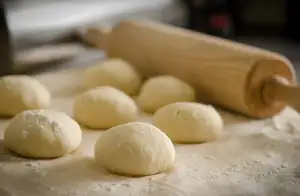Lefse: Unveiling the Delicate Flavors of Norway's Traditional Flatbread

- History and Origins of Lefse
- Ingredients Used in Lefse Making
- Traditional Lefse Recipe and Preparation Method
- Variations and Regional Adaptations of Lefse
- Serving and Enjoying Lefse: Popular Accompaniments and Dishes
- Lefse in Modern Cuisine: Creative Uses and Innovations
- Health Benefits of Lefse: Nutritional Value and Dietary Considerations
- Tips and Tricks for Making Perfect Lefse at Home
Lefse, a traditional Norwegian flatbread, is a culinary delight that has been enjoyed for centuries. This thin and delicate bread is made from simple ingredients and holds a special place in Norwegian cuisine. With its soft texture and subtle flavors, lefse is a versatile staple that can be enjoyed on its own or paired with various accompaniments. Join us as we delve into the world of lefse and uncover the secrets behind this beloved Norwegian delicacy.
History and Origins of Lefse
Lefse, a traditional Norwegian flatbread, has a rich history that dates back centuries. Its origins can be traced to the Vikings, who used to make a similar bread called "løfse." Over time, the recipe evolved and lefse became a staple in Norwegian cuisine. Originally, lefse was made using leftover potatoes and flour, as these ingredients were readily available. It was traditionally prepared during special occasions and holidays, such as Christmas and weddings. Today, lefse continues to be cherished as a beloved culinary tradition in Norway and has gained popularity worldwide.
Ingredients Used in Lefse Making
Lefse, the traditional Norwegian flatbread, is made using simple yet essential ingredients. The primary ingredient is potatoes, preferably starchy ones like Russet or Yukon Gold, which are boiled and mashed to create a smooth base. To enhance the flavor and texture, flour, butter, salt, and sometimes sugar are added to the potato mixture. This combination creates a soft and pliable dough that can be rolled out thinly. Some variations may include cream or sour cream for added richness. With just a handful of ingredients, lefse captures the essence of Norwegian cuisine in every bite.
Traditional Lefse Recipe and Preparation Method
To make traditional lefse, you will need the following ingredients: potatoes, all-purpose flour, butter, salt, and water. Start by boiling the potatoes until they are tender. Drain and mash them thoroughly. In a large mixing bowl, combine the mashed potatoes with flour, butter, and salt. Gradually add water to form a soft dough. Divide the dough into small balls and roll each one out into thin rounds on a floured surface. Cook the rounds on a hot griddle until they become golden brown and slightly crispy. Serve warm with butter or your favorite toppings.
Variations and Regional Adaptations of Lefse
Variations and regional adaptations of Lefse add a delightful twist to this traditional Norwegian flatbread. In different parts of Norway, you will find unique versions of Lefse that showcase the diverse culinary heritage of the country. Some regions use different types of flour, such as barley or rye, to create a distinct flavor profile. Additionally, variations in thickness, size, and cooking techniques can be found across different areas. Whether it's the thin and crispy version from southern Norway or the thicker and soft Lefse from the northern regions, each adaptation offers a unique experience for your taste buds.
Serving and Enjoying Lefse: Popular Accompaniments and Dishes
Lefse, with its soft and delicate texture, is a versatile flatbread that can be enjoyed in various ways. One popular way to serve lefse is by spreading it with butter and sprinkling it with sugar. This simple yet delicious combination brings out the subtle flavors of the bread.
Another classic accompaniment to lefse is lingonberry jam. The tartness of the jam complements the mild sweetness of the bread, creating a harmonious balance of flavors. Some also enjoy lefse with other types of jams, such as raspberry or strawberry, for a fruity twist.
In addition to sweet toppings, lefse can also be enjoyed with savory fillings. One traditional Norwegian dish is lefse rolls filled with cured meats like ham or smoked salmon, along with cream cheese and fresh herbs. These savory rolls make for a satisfying snack or light meal.
For those looking for a heartier option, lefse can be used as a wrap for various fillings. Common fillings include scrambled eggs, bacon, lettuce, and tomatoes. This combination creates a delicious breakfast or lunch option that is both flavorful and satisfying.
No matter how you choose to enjoy it, lefse is best served warm and fresh. Its soft texture makes it perfect for rolling up different ingredients or simply enjoying on its own. So go ahead and explore the endless possibilities of serving and enjoying this delightful Norwegian flatbread!
Lefse in Modern Cuisine: Creative Uses and Innovations
Lefse, the traditional Norwegian flatbread, has not only stood the test of time but has also found its way into modern cuisine with creative uses and innovative twists. Chefs around the world have embraced this versatile bread and incorporated it into a range of dishes. From using it as a wrap for gourmet sandwiches to serving it as a base for unique pizza creations, lefse adds a delicate flavor and texture that elevates any dish. Its thin and pliable nature makes it perfect for rolling up sushi-style or stuffing with flavorful fillings. Whether used in fusion cuisine or as a substitute for tortillas or crepes, lefse continues to surprise and delight food enthusiasts with its adaptability and ability to enhance flavors.
Health Benefits of Lefse: Nutritional Value and Dietary Considerations
Lefse, the traditional Norwegian flatbread, not only tantalizes our taste buds but also offers some health benefits. Made primarily from potatoes, lefse is a good source of carbohydrates, providing energy to fuel our bodies. It is low in fat and cholesterol-free, making it a healthier alternative to other bread options. However, it is important to note that lefse can be high in calories if consumed in large quantities or topped with butter and sugar. Moderation is key when enjoying this delightful treat.
Tips and Tricks for Making Perfect Lefse at Home
1. Use the right potatoes: Choose starchy potatoes like russets or Yukon Golds for a light and fluffy texture.
2. Don't overcook the potatoes: Overcooking can make the dough sticky and difficult to work with. Cook until just tender.
3. Rice the potatoes: Use a potato ricer to ensure a smooth consistency, free of lumps.
4. Chill the dough: After mixing the ingredients, refrigerate the dough for at least an hour to make it easier to roll out.
5. Roll thin: Roll out the dough as thin as possible without tearing, using a lefse rolling pin or a regular rolling pin with a cloth-covered surface.
6. Keep it cool: Work on a cool surface and keep the rolled-out dough chilled until ready to cook.
7. Use enough flour: Dust both sides of the lefse with flour while rolling and flipping to prevent sticking.
8. Cook on a griddle or skillet: Heat your cooking surface to medium-high heat and cook each lefse until golden brown spots appear on both sides.
9. Store properly: To keep lefse fresh, stack them between layers of wax paper or parchment paper and store in an airtight container in the refrigerator.
10. Enjoy fresh or freeze: Lefse can be enjoyed immediately or frozen for later use by wrapping them tightly in plastic wrap and storing in freezer bags.
In conclusion, Lefse is truly a delightful culinary tradition that showcases the rich history and flavors of Norway. Its delicate texture, subtle flavors, and versatility make it a beloved dish for Norwegians and food enthusiasts around the world. Whether enjoyed with butter and sugar or used as a wrap for savory fillings, Lefse never fails to satisfy the taste buds. So why not try your hand at making this traditional flatbread at home and experience the magic of Lefse for yourself?
Published: 18. 11. 2023
Category: Food



